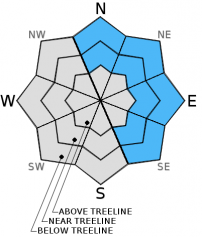| Monday | Monday Night | Tuesday | |
|---|---|---|---|
| Weather: | Mostly cloudy skies. | Mostly cloudy skies, becoming partly cloudy. | Partly cloudy skies. |
| Temperatures: | 29 to 36 deg. F. | 14 to 24 deg. F. | 31 to 38 deg. F. |
| Mid Slope Winds: | W | SW | S |
| Wind Speed: | Light winds | Light winds | Light winds increasing to 10 to 15 mph in the afternoon. |
| Expected snowfall: | 0 | 0 | 0 |
| Monday | Monday Night | Tuesday | |
|---|---|---|---|
| Weather: | Mostly cloudy skies. | Mostly cloudy skies, becoming partly cloudy. | Partly cloudy skies. |
| Temperatures: | 31 to 38 deg. F. | 14 to 21 deg. F. | 31 to 38 deg. F. |
| Ridge Top Winds: | W | SW | SW |
| Wind Speed: | 10 to 15 mph with gusts up to 25 mph in the afternoon. | 10 to 15 mph. | 15 to 20 mph. Gusts up to 35 mph in the afternoon. |
| Expected snowfall: | 0 | 0 | 0 |
























